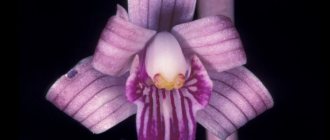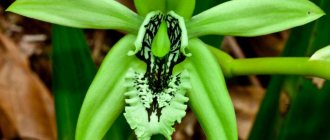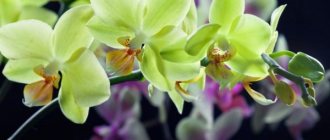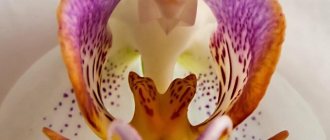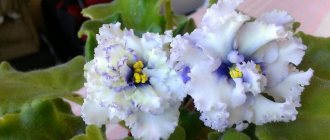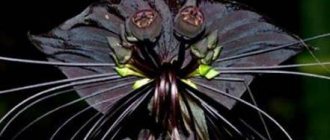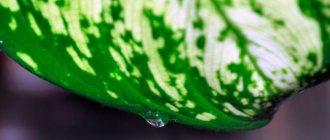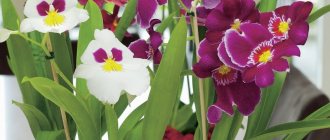There are more than one hundred thousand species and varieties in the orchid family. Flowers with leopard coloring are the object of close attention of lovers of epiphytic plants. Cleopatra is a popular type of phalaenopsis that has taken root well in indoor conditions.
There is no exact information about the origin of the species. It is only known that the orchid was bred artificially and belongs to the Phalaenopsis hybrid species.
Detailed description and photo
The Cleopatra Orchid is a fairly well-known flower among plant growers. The Latin name is Phalaenopsis hybridum, the plant was obtained through an artificial route. Cleopatra is part of the Phalaenopsis group . Two flowers can differ from each other:
- colors;
- speck shape;
- the size of the flower.
The basic colors of the orchid are white-yellow and white. Usually, after a while, shades begin to lose their brightness and saturation.
The most colorful feature is the intricate speckling. The dots can be pink, lilac or purple. Thanks to these grains an unusual pattern is created!
The plant is 60 to 70 centimeters tall. It has 3-7 leaves of bright green color, the length of which is 10-30 centimeters. These leaves are collected in a rosette, and flower stalks up to 70 centimeters long grow from the rosette. A new leaf appears at 4-8 months.
Now let's talk about Cleopatra's parts. The sepals are oval in shape and medium in size. The main color is white or slightly yellowish. There are small lilac specks along the background. The column is small, has a lilac base and upper surface, and a white beak is also present.
The petals have a round, symmetrical shape. The petals themselves are white or slightly yellowish, with many lilac specks. The diameter of the flower is no more than 7 centimeters. The lip is large, three-lobed, lilac in color with white highlights. The roots are aerial and well developed. They are grayish-green or deep green in color.
The Cleopatra orchid lives from 10 to 15 years; towards the end of its life it is renewed.
Description
Cleopatra is a phalaenopsis. This genus holds a kind of popularity record . These plants are the best-selling potted flowers in the world. Beauty Cleopatra is one of the many phalaenopsis hybrids. In the photo below you can see this wonderful orchid.
The Cleopatra Orchid is a very popular flower among gardeners.
It was bred artificially and is quite unpretentious, so it can be safely recommended to be grown even by novice gardeners .
Well adapted to life in a modern apartment with low humidity. If minimal conditions are met, it feels great, regularly delighting with abundant flowering .
This commercial name perfectly characterizes Cleopatra. Her charming appearance captivates at first sight. They say that the charming queen of ancient Egypt also had the magical gift of instantly making people fall in love with her.
Some Cleopatra fans purchase several plants of this species, comparing them with each other. Two plants will always be different from each other:
- Shade;
- Speck shape;
- Or the size of a flower.
Each orchid is unique! Lighting also affects its appearance - the same plant looks completely different in the sun and in lamplight.
The main background of the Cleopatra orchid is white or white-yellow. Usually at the beginning of flowering the plant has more saturated shades, and over time it turns pale.
The most noticeable feature is the intricate speckling . Lilac, pinkish or purple dots create an intricate pattern. But there is a Cleopatra rosea orchid.
How is it different from other types?
- The plant has a long flowering period. This is considered the most important distinguishing feature.
- The flower has a rather rare color. Because of this, Cleopatra is quite difficult to find in a flower shop.
- The Cleopatra Orchid has a distinct originality. It is impossible to find 2 flowers that are completely the same. Each has its own “zest”.
You can often see people discussing the subspecies of the Cleopatra Butterfly orchid. In simple words, a Cleopatra butterfly is an orchid with incorrectly developed petals . This may be due to various reasons:
- Genetic mutations.
- Special conditions of detention.
Flower growers in this regard are divided into 2 groups:
- The first group considers this defect attractive and even some are willing to pay 2 times more for such a plant.
- The second group is categorically against such changes.
Distinctive characteristics of an orchid with photo
Cleopatra is a well-known variety among orchid lovers. Botanical name: Phalaenopsis Cleopatra.
Features of the species are:
- a long flowering period is the main distinguishing feature;
- the rare color of the plant, which makes Cleopatra difficult to find in the store;
- the uniqueness of the colors of each bud, among which you cannot find 2 identical ones.
The variety is characterized by a basic white-yellow and white color; after some time, the brightness and richness of the shades is lost.
The flowers are different:
- colors;
- speckled shape;
- size.
Characteristics of the species:
- a plant with a monopodial growth pattern that develops upward;
- fleshy, oval leaf blades of large size, raised 45° relative to the stem;
- without the flower arrow, the height of the stem is 30 cm;
- An orchid often has 3–7 green leaves 10–30 cm long, collected in a rosette, from which flower stalks up to 70 cm grow;
- the crop has shortened internodes with two-row arrangement of leaves;
- roots are thick, long, greenish-pearl-colored, which absorb and retain moisture and participate in photosynthesis.
Orchids Wildcat and Cleopatra are often confused due to the external similarity of the buds. The differences are in the location of the spots. Wildcat has dense mottling that makes the flower appear purple from a distance.
In Cleopatra, the dots are spaced less frequently, the color is more noticeable, and the flower looks lighter and more graceful.
Bloom
The Cleopatra orchid can bring pleasure to its owner at any time of the year, and especially from January to June. There are approximately 10 pieces in an inflorescence. The flowers last quite a long time, up to 6 months. While the lowest flowers fall off, new ones begin to bloom at the top. There is no need to cut off the peduncle after flowering.
For flowering, the plant requires a difference in day and night temperatures, as well as a period of rest.
If your orchid does not bloom, then you can help it with this. You need to put the pot with Cleopatra in a cool room (about 15 degrees) for 1-2 months. After this everything will be fine.
Also, during the flowering period, it is advisable to spray the flower with microfertilizers , which contain manganese, molybdenum, boron, vitamins and other useful substances.
Reproduction of Cleopatra
Typically, the most reliable way to propagate plants is through division. But not in the case of Cleopatra: a flower has only one growth point for its entire life (of course, there are anomalous exceptions).
Therefore, other options remain:
- Seeds. We must honestly admit: this is for professionals, since it requires almost laboratory conditions, sterility, a special container for sowing, soil treatment, and a lamp. And when the seeds sprout, there are two more years of painstaking care for the seedlings, so that later, finally, they can be planted in separate pots.
The seedlings will bloom only after 7 years. And perhaps they will produce completely different flowers from which the seeds were taken.
- Processes. Sometimes shoots appear near the faded peduncle. Now they can be carefully separated from the mother stem, when well-developed roots 5-6 cm long are already visible. True, this opportunity will come in 6 months, and before that time the baby will first have leaves, and then roots. The detached shoot must be kept for some time in water with a growth stimulator and planted in a mini-pot with substrate. Then it needs the same conditions as an adult orchid.
Orchid shoots
It will also be interesting: Cattleya Orchid - home care and propagation of indoor plants?
How much does an adult plant cost in the store? Where can I buy it?
On average, the cost of a good adult plant is from 700 rubles. up to 2000 rub . The price may depend on:
- Plant color. As a rule, it all depends on the rarity of the color.
- Number of peduncles. The more flower stalks, the higher the cost.
- The country from which the orchid was brought. The more prestigious the country, the more expensive the flower.
You can buy a Cleopatra orchid online or look for it in flower shops in the city. But, as practice has shown, it is recommended to buy attractive and well-groomed flowers through online stores.
Structure: photo and description in pictures
Phalaenopsis have structural features that arose in the process of adaptation to the specifics of their habitat.
Butterfly flower formula
Phalaenopsis usually produces several buds. Flower structure:
- sepals - one upper sepal and two lower lateral ones;
- petals - side petals;
- labellum (lip), or modified central petalia to attract pollinating insects;
- column - connected pistils and stamens.
Root system
Phalaenopsis has an aerial root system. Thanks to long shoots, the flower is attached to large plants or stones. They are covered with a thick layer of velamen - rough, dead, porous tissue. Through it, the orchid absorbs moisture and nutrition from the atmosphere and tree bark.
Leaves
The foliage is elastic, dense and leathery, oblong in shape, rounded at the end, located opposite. At home, the length of the leaves varies from 5 to 40 cm. With a lack of lighting, the leaves lengthen and become thinner. The color shade is predominantly solid green, but there are species with a spotted marble pattern. They are able to absorb moisture and retain it when the flower lacks water from the roots.
Stem and peduncle
Phalaenopsis has a vertical (monopodial) and short trunk, enlarged by leaves. In young orchids, each growth is larger than the previous one, in adults it is the same. The peduncle is long and often branches. It develops from a bud on a shoot and grows upward.
Fruit
The fruits are set in the form of a green box of three scales connected by edges. When ripe, several cracks open on it. Inside are microscopic dust-like seeds of a yellow-cream color.
Peloric
Peloric is a mutated phalaenopsis in which the structure of the flower is changed due to a disrupted gene. It can be stable or not, which depends on the variety. Examples of peloric varieties:
- Butterfly - can simultaneously have both regular buds and modified ones (semipeloric).
- Kaleidoscope - one or two peduncles, yellow-orange petals with red veins and streaks.
- Burgundy - depending on the hybrid, the petals are completely red-burgundy or covered with a red-brown mesh.
- Yellow - peduncle up to 70 cm, buds are white-yellow with a slight shade of purple.
- Legato - two inflorescences grow, each with light pink buds with an orange lip.
- Mini - many hybrids of various shades with stable peloricity.
What kind of soil is needed?
The substrate is a special bark with pieces of charcoal and sphagnum . It can be bought at flower shops, just like pots.
You can also make your own soil mixture. Need to combine:
- peat;
- pieces of pine bark;
- moss;
- charcoal.
We wrote about whether an orchid needs drainage here.
Conditions of detention
Selecting a location
The most optimal place for keeping it is a window sill on the east or west side. You can also place a flowerpot with a plant in the northern part of the house, providing it with artificial lighting in the winter. For instances placed in the center of the room, a lamp will be required.
You should not keep the flower on a south or south-west window, where there is a high risk of burning the foliage during lunch hours. If you do not have such an opportunity, you can hang a curtain that will protect from scorching rays.
Lighting
This is a long-duration plant - it requires 10-12 hours of diffused daylight per day. In summer it is obtained naturally, in winter it is illuminated with fluorescent lamps.
Temperature
When spraying, water should not get on the flowers.
Optimal values during the day are from 20 to 26°C, at night they can be lowered to 12-15°C. Such changes have a beneficial effect on flowering.
Humidity
The orchid prefers to grow in a room with moderate humidity. To maintain this figure at 80-85% in the summer, in autumn and winter it is reduced to 70-75%. To do this, the flower is periodically irrigated with warm water and the inflorescences are protected from moisture.
In extreme heat, place a container of water in the room.
The substrate humidity should be low, especially during periods when the plant is not blooming. At this time of year, long-term drying of the soil mixture is carried out.
Substrate
When growing a flower in a hanging basket, no substrate is used. If it is a potted crop, then the container is filled with a special composition that you can prepare yourself:
- dried pieces of pine bark without resins and wood residues;
- optimal size - 1-1.5 cm;
- they are boiled for several minutes, then drained, refilled with clean water and boiled again;
- removed from the container, dried in an oven at low temperature so that the fragments do not burn;
- mixed with birch tar in a ratio of 4:1.
Capacity
There are many options for planting containers for this plant, but plastic, preferably transparent, is recognized as the best. It should be a container with smooth edges and drainage holes at the bottom.
- There are several advantages of such a flowerpot:
- the roots will have access to sunlight, so the process of photosynthesis will not be disrupted;
- thanks to the smooth surface, the risk of injury is eliminated;
- the opportunity to examine the condition of the roots, and in case of damage, quickly take the necessary measures to resuscitate the flower.
The dimensions of the pot must correspond to the size of the root system, just take 2-3 cm larger in diameter.
Landing
You need to prepare all the necessary materials in advance. The pot should be transparent and have drainage holes on the sides . It is also recommended to take a pot that is neither deep nor narrow. This is done to ensure that the roots have access to light and oxygen.
The roots should be disinfected with a nutrient solution before planting.
Afterwards, the plant needs to be planted in the pot itself with soil and filled in, filling the voids. Next, water everything well and you’re done!
Phalaenopsis Cleopatra orchid: photo
There are several types of orchids that differ in their rare flower colors. One of these varieties is the Phalaenopsis Cleopatra orchid.
Growing Phalaenopsis Cleopatra Orchid
Seeds
Growing a flower from seeds is a painstaking process. The special box is pre-treated, the prepared soil is filled in and the seed is planted. The container is tightly closed until the first sunrise. The orchid has a long period of growth and vegetation. After 1.5 - 2 years, the plant is transplanted into a special pot.
Rostcom
The sprout should have a weak root system, 3 – 5 leaves per column and a healthy appearance. Plant in a prepared pot, having previously treated the roots with a nutrient solution. After planting, the plant is watered abundantly and normal plant care begins.
Home care
The flower is completely unpretentious to care for, but in order for it to please you for a long time, the following conditions must be met:
- Provide proper lighting . It is strictly forbidden for the orchid to be exposed to direct sunlight, as this may cause burns on the petals.
- Observe the temperature regime . During the day – +20-24 degrees, and at night – +18 degrees. The plant really does not like sudden changes in temperature.
- Ventilation of the room . It is worth ventilating the room 1-2 times a day, but there should be no drafts.
- High air humidity – at least 70-80%. In hot weather, it is recommended to spray the plant with soft water at room temperature.
- Regular watering . The orchid needs to be watered 1-2 times a month. In hot weather, watering is increased. Water for irrigation should be soft, settled and at room temperature.
- Feeding . Special fertilizers for orchids can be found in flower shops.
Cleopatra Orchid - description, care, reproduction, transplants
The Cleopatra orchid is an epiphytic phalaenopsis. It was bred artificially and is one of the most popular and best-selling potted plants due to its amazing color and long flowering. A pleasant quality, especially for beginner gardeners, is Cleopatra’s unpretentiousness and her quick adaptation to apartment conditions.
Characteristics of the Cleopatra variety
Phalaenopsis Cleopatra at home grows to 60-65 cm in height. The peduncle reaches up to 45-48 cm no more. Each stem bears delightful flowers, reminiscent of flying moths, growing up to 8 cm in diameter. On one peduncle you can count about 10 buds.
Cleopatra blooms most often starting in January and ending in June, but flowering can also occur at other times of the year. Flowers bloom in stages: after the lower ones fall, the upper ones open.
Orchid color
A distinctive feature of Phalaenopsis Cleopatra is its color. On the general white, sometimes white-yellow background of the flower, identical regular spots of purple are randomly scattered. The edges of the petals are variegated with them, and closer to the middle the number of spots noticeably thins out. The unusually shaped core of the flower is also painted in a rich purple color.
Leaves and roots
The Cleopatra orchid has from 3 to 7 dense oval leaves, painted in a rich green color, growing from 10 to 30 cm in length and pointed at the ends. The roots are aerial, well developed. Their color varies from grayish-green to bright green.
Growing the variety
To grow a healthy phalaenopsis Cleopatra, you should create the necessary conditions, make some effort and be patient. First of all, you need to decide on a place for the flower, which should be well lit, but at the same time protected from direct rays of the sun. And also ensure the required temperature conditions and required air humidity.
Landing of Cleopatra
Before you start planting, you should prepare the pot in advance and purchase the necessary soil mixture. You can make it yourself by mixing peat, pieces of pine bark, charcoal and sphagnum moss.
To provide the roots with good access to light and oxygen, it is recommended to use a transparent pot with drainage side holes for planting. The root system of an orchid grows in width, so you should take a container that is not too deep and not narrow. Be sure to place a drainage layer on the bottom.
Phalaenopsis Cleopatra is grown by seeds and sprouts. The seed method is more lengthy and requires more attention.
The prepared soil mixture is poured into a special, pre-treated container, into which the seeds are planted.
The container is covered with film or well closed with a transparent lid until the first sprouting seedlings appear. The young plant is transplanted into a pot after 1.5-2 years.
The sprout for planting is healthy, with good roots and 3-5 leaves. The roots are treated with a nutrient solution before planting. The sprout is then placed in a pot with a special substrate and filled in, filling the empty cavities. Afterwards, the young phalaenopsis should be watered generously and continue to be cared for as usual.
Orchid care
Although the Cleopatra variety was bred artificially, this plant belongs to the tropical. Therefore, it is necessary to provide him with conditions close to natural ones. For this it is important:
- provide the flower with adequate lighting, avoiding direct rays of the sun, which leave burns on delicate petals and foliage;
- do not forget about the correct temperature regime. During the day the temperature should remain at +20-24 degrees, at night - at +18. Sudden changes in temperature should be avoided. Phalaenopsis does not tolerate extreme heat and cold; in such cases, the flower may die;
- It is mandatory to ventilate the room with the plant, but drafts should not be allowed;
- Cleopatra needs high air humidity, which should be at least 70-80%. To do this, in the hot season and when the heaters are on, it is recommended to spray the flower with soft, settled water;
- Water the plant regularly. On average, a flower is watered 1-2 times a month; in hot weather, the number of waterings can be increased, based on the drying out of the substrate. Water for irrigation should be soft, well-settled, and at room temperature;
- do not forget to feed the phalaenopsis. To do this, apply liquid fertilizers specifically designed for orchids in accordance with the instructions.
Pruning and replanting
The Cleopatra orchid is replanted every 2-3 years. The most suitable time for transplantation is spring or early summer. If the plant blooms, it is better to wait until flowering is complete and only then replant it. Before you begin the replanting process, you should prepare a new pot and purchase the necessary nutrient substrate. Then you need to do the following:
- carefully, so as not to damage the root system, remove the orchid from the pot;
- remove rotten roots and treat healthy roots with a special strengthening solution;
- Place drainage and prepared soil mixture at the bottom of the new pot;
- place the flower in it and sprinkle with the remaining substrate so that there are no empty spaces between the roots.
After transplantation, care for phalaenopsis Cleopatra as usual. The orchid should not be watered immediately, but a couple of days after replanting.
To encourage abundant flowering the following season after the orchid has finished blooming, all buds are trimmed.
Diseases and pests
The main cause of orchid disease and the appearance of harmful insects is improper care. The plant can suffer and even die from sunburn, excess moisture, and even from the wrong size and shape of the pot.
If the plant begins to rot in different places, this may be a symptom of a fungal infection. To cure a flower, you need to remove all infected parts and treat it with foundationazole. In some cases, you can save the plant only by replanting it, after cutting off the peduncle and treating the phalaenopsis with special products intended for the treatment of orchids.
If sunburn occurs, you should remove the damaged parts and be sure to shade the flower in the future.
Pest Control
When harmful insects appear that feed on phalaenopsis sap, yellowed leaves and the formation of ulcers and stickiness on them may be indicated. The most common include scale insects, spider mites, aphids, and mealybugs. To get rid of pests, you should treat the plant with special insecticides.
Prevention
The main condition for the prevention of diseases and pests is proper proper care. If the orchid is replanted and trimmed in time, the room with it is maintained at the required temperature and humidity, ventilated and watered regularly and correctly, you can avoid many problems that lead to deterioration in health and, at times, to the death of the plant.
We offer a video review of the Cleopatra orchid:
Source: //VseoLady.ru/orxideya-kleopatra.html
Transfer
The Cleopatra orchid is replanted once every 2-3 years. The most suitable time period is spring or early summer. It is not recommended to replant during the flowering period.
How to transplant:
- Carefully remove the root orchid from the container.
- Trim off the rotten roots and sprinkle with crushed coal.
- Prepare the pot. Place drainage at the bottom and cover it with soil.
- Plant a plant there and cover it with soil.
That's the whole scheme. Watering is not carried out immediately, but several days after transplantation.
Cleopatra butterflies: expert opinion
Sometimes on forums you can find discussions and photographs of one of the varieties of the Cleopatra butterfly orchid. To understand what it is, you need to remember the structure of the phalaenopsis flower:
- three sepals arranged in a triangle - sepals;
- two petals located horizontally opposite each other;
- petal-lip.
In normal phalaenopsis, the petals are large and round. But sometimes deviations and deformations occur. Flowers with deformed petals are called peloric:
- if the petals have a shape completely identical to the lip, the flower is called peloric;
- if the shape of the petals does not completely copy the shape of the lip, but has a deviation, the flower is called semipeloric.
Cleopatra butterfly is a semipeloric, that is, an orchid with improperly developed petals. Peloricity occurs in orchids for various reasons. These could be genetic mutations or special growing conditions. Experts have an ambiguous attitude towards this phenomenon. Some consider it a charming phenomenon and are working to consolidate peloric forms. In the American Orchid Society, on the contrary, there is a conservative approach, and pelorics may not be allowed at exhibitions.
“Amateur flower growers are sometimes too keen on hunting for “butterflies”, “trilips”, “bows” and other pelorics and semipelorics. Some are even willing to overpay almost double for such copies. But we must not forget that peloricity is a very unstable quality. The plant can now bloom as a peloric, and next time it will produce regular flowers. And every other time - both ordinary and peloric on one peduncle.”
E. Rudnik, biologist, landscaper
The Cleopatra butterfly orchid has an uneven shape of petals, vaguely reminiscent of the three-lobed shape of a lip. For lovers of exotic effects, this is an attractive quality, but it will not necessarily be repeated the next time it blooms.
How does Cleopatra reproduce?
The Cleopatra orchid is propagated in 2 ways:
- Vegetative method . We need to wait until the babies appear on the flower stalks. After they have produced roots, they are carefully separated from the mother plant and planted in individual small containers.
- Seed method . This method is difficult to implement at home. Initially, what needs to be done is to perform artificial pollination. Next, wait 8-9 months for the seeds to ripen. Then the seeds are collected and a special medium is prepared in which the seeds are germinated and for several months the seedlings grow in sealed flasks.
Diseases and pests
Due to improper maintenance, Cleopatra may develop various diseases:
- Yellowing . Often the culprits of such a disease are pests. The flower should be disinfected with Fitoverm or another insecticide.
- Fungal disease . The result may be rotting of parts of the plant. Damaged parts are trimmed and treated with Fundazol.
- Sunburn is not a disease, but this exposure also damages the orchid.
